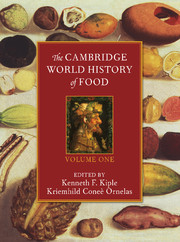Book contents
- Frontmatter
- Introduction
- Part I Determining What Our Ancestors Ate
- Part II Staple Foods: Domesticated Plants and Animals
- II.A Grains
- II.B Roots, Tubers, and Other Starchy Staples
- II.C Important Vegetable Supplements
- II.D Staple Nuts
- II.E Animal, Marine, and Vegetable Oils
- II.F Trading in Tastes
- II.G Important Foods from Animal Sources
- II.G.1 American Bison
- II.G.2 Aquatic Animals
- II.G.3 Camels
- II.G.4 Caribou and Reindeer
- II.G.5 Cattle
- II.G.6 Chickens
- II.G.7 Chicken Eggs
- II.G.8 Dogs
- II.G.9 Ducks
- II.G.10 Game
- II.G.11 Geese
- II.G.12 Goats
- II.G.13 Hogs (Pigs)
- II.G.14 Horses
- II.G.15 Insects
- II.G.16 Llamas and Alpacas
- II.G.17 Muscovy Ducks
- II.G.18 Pigeons
- II.G.19 Rabbits
- II.G.20 Sea Turtles and Their Eggs
- II.G.21 Sheep
- II.G.22 Turkeys
- II.G.23 Water Buffalo
- II.G.24 Yak
- Part III Dietary Liquids
- Part IV The Nutrients – Deficiencies, Surfeits, and Food-Related Disorders
- References
II.G.21 - Sheep
from II.G - Important Foods from Animal Sources
Published online by Cambridge University Press: 28 March 2008
- Frontmatter
- Introduction
- Part I Determining What Our Ancestors Ate
- Part II Staple Foods: Domesticated Plants and Animals
- II.A Grains
- II.B Roots, Tubers, and Other Starchy Staples
- II.C Important Vegetable Supplements
- II.D Staple Nuts
- II.E Animal, Marine, and Vegetable Oils
- II.F Trading in Tastes
- II.G Important Foods from Animal Sources
- II.G.1 American Bison
- II.G.2 Aquatic Animals
- II.G.3 Camels
- II.G.4 Caribou and Reindeer
- II.G.5 Cattle
- II.G.6 Chickens
- II.G.7 Chicken Eggs
- II.G.8 Dogs
- II.G.9 Ducks
- II.G.10 Game
- II.G.11 Geese
- II.G.12 Goats
- II.G.13 Hogs (Pigs)
- II.G.14 Horses
- II.G.15 Insects
- II.G.16 Llamas and Alpacas
- II.G.17 Muscovy Ducks
- II.G.18 Pigeons
- II.G.19 Rabbits
- II.G.20 Sea Turtles and Their Eggs
- II.G.21 Sheep
- II.G.22 Turkeys
- II.G.23 Water Buffalo
- II.G.24 Yak
- Part III Dietary Liquids
- Part IV The Nutrients – Deficiencies, Surfeits, and Food-Related Disorders
- References
Summary
Probably the earliest domesticated herd animal in the Old World, the sheep (Ovis aries) makes an unparalleled contribution of food and fiber. The great advantage of these small ruminants is their ability to digest the cellulose of wild grasses and coarse woody shrubs in their complex stomachs and convert it into usable products.
Origin and Domestication
Sheep were domesticated on the flanks of the Taurus–Zagros Mountains, which run from southern Turkey to southern Iran. Within that arc is found the urial (Ovis orientalis), a wild sheep now generally regarded as the ancestor of the domesticated sheep. Early archaeological evidence of sheep under human control comes from Shanidar Cave and nearby Zaqi Chemi in Kurdistan. Sheep bones recovered in abundance at these two sites have been dated to between 8,000 and 9,000 years ago and contrast with other Neolithic sites close to the Mediterranean, where similar evidence of domesticated sheep is rare. However, accurate species identification has posed problems, for the bones of goats and sheep are often difficult to distinguish from one another. Therefore, some archaeological reports have grouped them together as “sheep/goat” or “caprine.”
The domestication process that transformed O. orientalis into O. aries involved several key changes. The body size of the sheep was reduced from that of the urial. Diminution could have been accomplished over many generations by culling out larger, aggressive males as sires. Selection also occurred for hornlessness, but this process is not complete. Although many breeds of domesticated female (and some male) sheep typically have no horns, in other males the horns have only been reduced in size. Domesticated sheep also have a long tail as compared with the wild ancestor. The most significant physical transformation of the animal was the replacement of the hairy outercoat with wool fibers, which turned the sheep into much more than a food source. As early as 6,000 years ago,woolly sheep had differentiated from hairy sheep, and in ancient Mesopotamia, the raising of wool-bearing animals was a major activity in lowland areas. Selection for white-wooled animals explains the gradual dominance of that color.
- Type
- Chapter
- Information
- The Cambridge World History of Food , pp. 574 - 578Publisher: Cambridge University PressPrint publication year: 2000

